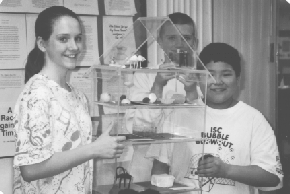
The Record - May 1998
At the Presidential Libraries
Timothy Walch, Editor
Building Bridges Between the Museum
and the Classroom
By Timothy Walch and Mary Evans
Small world isn't it? We have all used that remark without much thought. Generally, the phrase is used to describe an unusual coincidence. This winter, the staff of the Hoover Presidential Library and the students and teachers of the Ernest Horn Elementary School in Iowa City learned that the phrase could have a double meaning!

Students of the Horn School in Iowa City show off their work.
Unbeknownst to one another, Hoover Library curator Maureen Harding and Horn School teacher Marjorie Hood delved into the world of miniatures last January. Harding planned and installed "No Big Deal: The Art of Miniatures," an exhibit devoted to the smallest of the small. At the same time, Ms. Hood was developing a curricular unit that focused on miniature characters in literature, microorganisms in science, and fractions in mathematics. The exhibit opening and the beginning of the unit in the same week was pure coincidence.
Once Ms. Hood learned of the Hoover exhibit, she incorporated it into her unit. In fact, a student tour of the exhibit was the kick-off for the unit. "I really enjoyed seeing the exhibit," noted Horn student Katie DePrenger. "It was awesome—and I got some great ideas for making miniatures!" Allie Warth and Phillip Rapp were surprised that the Hoover Museum would have an exhibit on miniatures, but it all made sense when they learned that Herbert and Lou Henry Hoover collected miniature Chinese porcelains and tiny jade animals.
All of the students were inspired by the exhibit. Jennifer Merickel, Matthew Ghabel and Matthew Ropp all agreed that "No Big Deal" was a great way to begin this thematic unit— and it really was a "big deal" to visit the Hoover Museum. Ms. Hood added that learning takes place in lots of different places including museums such as the Hoover Library!
Back in their classrooms at the Horn School, the students immersed themselves in miniatures—thinking, sharing, assessing, imagining, and even building miniatures. All of the fifth and sixth graders at the school participated in the process. It was a totally integrated approach to learning.
Ms. Hood attributed the success of the unit to several factors. To be sure, she was very pleased to have the Hoover Library exhibit as a way to build excitement among the students at the beginning of the unit. But even more important was the willingness of her fellow teachers to work together in common cause. Teamwork, Ms. Hood added with emphasis, insured the success of the unit.
The unit challenged students to develop specific life skills. They had to solve problems, develop perspective, write letters, and assist those in need. Some students struggled with each part of the unit, but all agreed that the overall experience was very satisfying.
And even a veteran teacher like Ms. Hood could be surprised. Before the unit began, she was sure that gender would be a problem. More specifically, how would sixth grade boys respond to doll houses and other miniatures? To Ms. Hood's surprise, the boys enjoyed themselves!
Museum and schools are natural partners. Together they present students with an enriching partnership of ideas, discovery, challenge, and fun; it is a partnership well worth sustaining. For a few months in the winter of 1998, the Herbert Hoover Presidential Library Museum and the Ernest Horn School in Iowa City built a bridge between the museum and the classroom. And the Hoover Library is determined to build other bridges to other schools in the coming year.
Timothy Walch is Director of the Herbert Hoover Library; Mary Evans is the Library's Education Specialist.